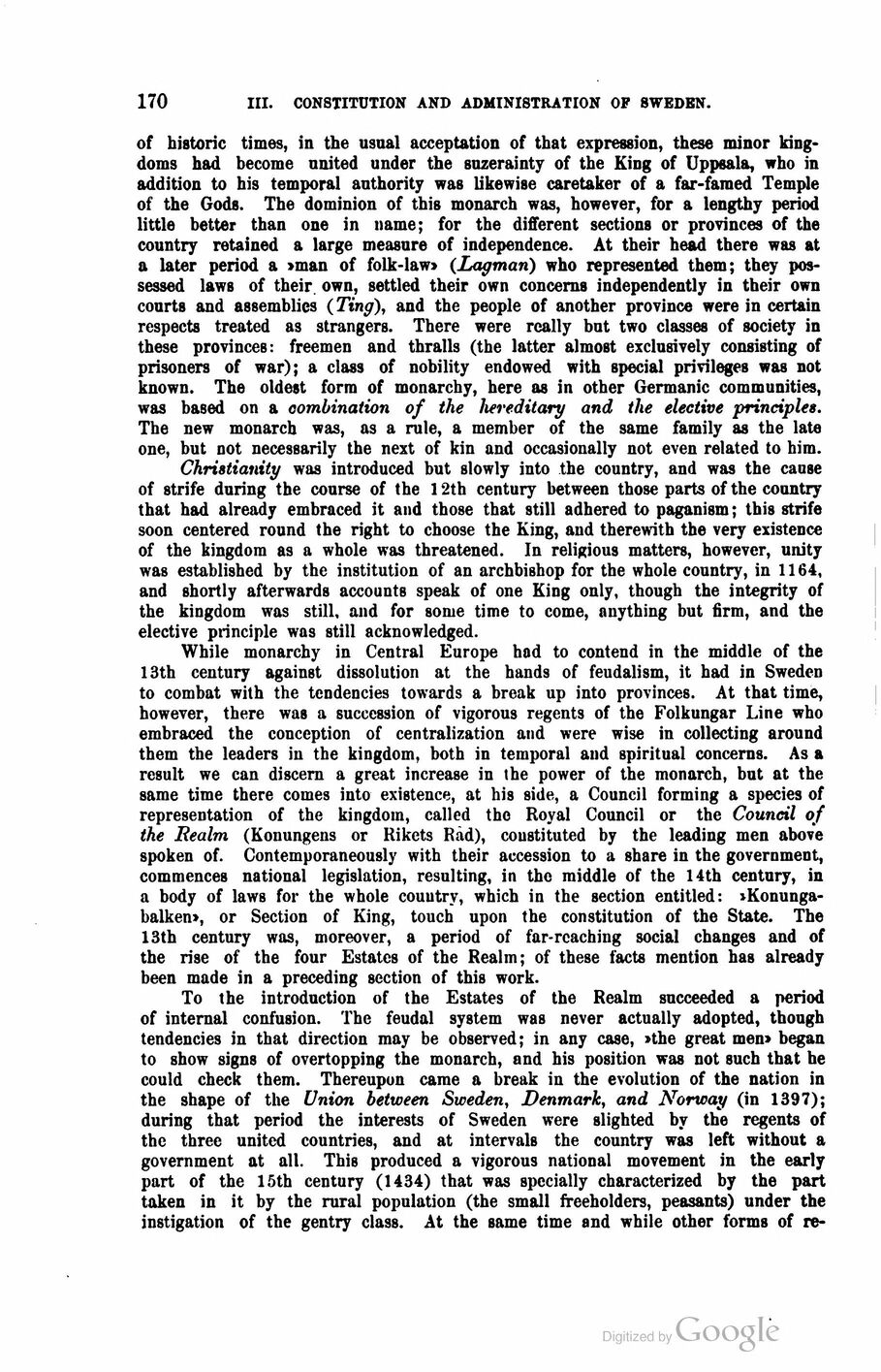
Full resolution (JPEG) - On this page / på denna sida - First part - III. Constitution and Administration - 1. Constitution - Historical Account and present Constitution, by E. Hildebrand, Ph. D., Chief of the National Record Office, Stockholm

<< prev. page << föreg. sida << >> nästa sida >> next page >>
Below is the raw OCR text
from the above scanned image.
Do you see an error? Proofread the page now!
Här nedan syns maskintolkade texten från faksimilbilden ovan.
Ser du något fel? Korrekturläs sidan nu!
This page has never been proofread. / Denna sida har aldrig korrekturlästs.
170
III. CONSTITUTION AND ADMINISTRATION OF SWEDEN.
of historic times, in the usual acceptation of that expression, these minor
kingdoms had become united under the suzerainty of the King of Uppsala, who in
addition to his temporal authority was likewise caretaker of a far-famed Temple
of the Gods. The dominion of this monarch was, however, for a lengthy period
little better than one in name; for the different sections or provinces of the
country retained a large measure of independence. At their head there was at
a later period a »man of folk-law» (Lagman) who represented them; they
possessed laws of their own, settled their own concerns independently in their own
courts and assemblies (Ting), and the people of another province were in certain
respects treated as strangers. There were really but two classes of society in
these provinces: freemen and thralls (the latter almost exclusively consisting of
prisoners of war); a class of nobility endowed with special privileges was not
known. The oldest form of monarchy, here as in other Germanic communities,
was based on a combination of the hereditary and the elective principles.
The new monarch was, as a rule, a member of the same family as the låte
one, but not necessarily the next of kin and occasionally not even related to him.
Christianity was introduced but slowly into the country, and was the cause
of strife during the course of the 12th century between those parts of the country
that had already embraced it and those that still adhered to paganism; this strife
soon centered round the right to choose the King, and therewith the very existence
of the kingdom as a whole was threatened. In religious matters, however, unity
was established by the institution of an archbishop for the whole country, in 1164,
and shortly afterwards accounts speak of one King only, though the integrity of
the kingdom was still, and for some time to come, anything but firm, and the
elective principle was still acknowledged.
While monarchy in Central Europe had to contend in the middle of the
13th century against dissolution at the hands of feudalism, it had in Sweden
to combat with the tendencies towards a break up into provinces. At that time,
however, there was a succession of vigorous regents of the Folkungar Line who
embraced the conception of centralization and were wise in collecting around
them the leaders in the kingdom, both in temporal and spiritual concerns. As a
result we can discern a great increase in the power of the monarch, but at the
same time there comes into existence, at his side, a Council forming a species of
representation of the kingdom, called the Royal Council or the Council of
the Realm (Konungens or Rikets Ràd), constituted by the leading men above
spoken of. Contemporaneously with their accession to a share in the government,
commences national legislation, resulting, in tho middle of the 14th century, in
a body of laws for the whole couutrv, which in the section entitled:
»Konunga-balken», or Section of King, touch upon the constitution of the State. The
13th century was, moreover, a period of far-reaching social changes and of
the rise of the four Estates of the Realm; of these facts mention has already
been made in a preceding section of this work.
To the introduction of the Estates of the Realm succeeded a period
of internal confusion. The feudal system was never actually adopted, though
tendencies in that direction may be observed; in any case, »the great men» began
to show signs of overtopping the monarch, and his position was not such that he
could check them. Thereupon came a break in the evolution of the nation in
the shape of the Union between Sweden, Denmark, and Norway (in 1397);
during that period the interests of Sweden were slighted by the regents of
the three united countries, and at intervals the country was left without a
government at all. This produced a vigorous national movement in the early
part of the 15th century (1434) that was specially characterized by the part
taken in it by the rural population (the small freeholders, peasants) under the
instigation of the gentry class. At the same time and while other forms of re-
<< prev. page << föreg. sida << >> nästa sida >> next page >>